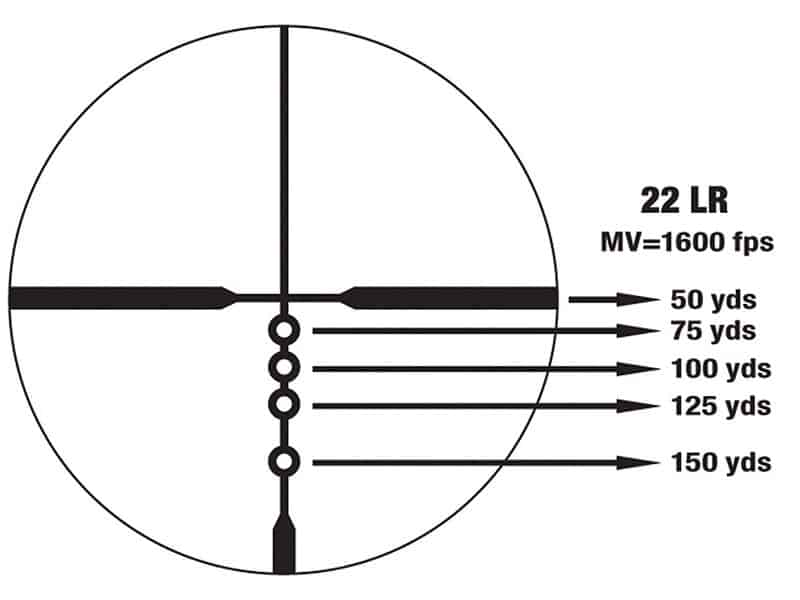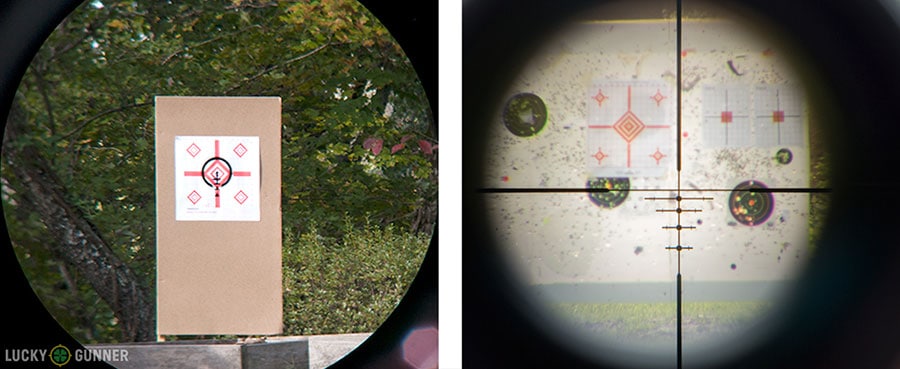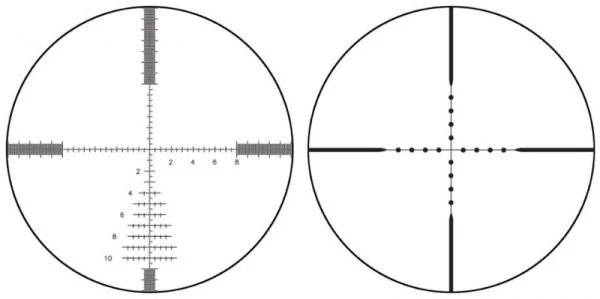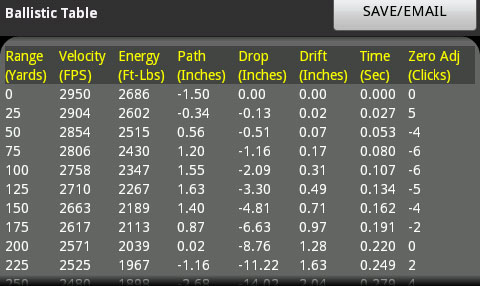
When it comes to a BDC scope, most gun owners will either love it or hate it. While it’s never been a huge hit with the firearm community, it’s slowly becoming more and more popular as the concept evolves with modern technology. While they aren’t exactly perfect, a BDC reticle scope can offer plenty of benefits just the same. So, let’s talk about what a BDC scope is and how it works, and what benefits you can get from using it.
How Does a BDC Reticle Work?

A BDC reticle stands for Bullet Drop Compensator. A Bullet Drop Compensating Reticle is a form of optic that employs a vertical axis along with multiple points of reference along that axis. This reticle will estimate how far a bullet will travel over a certain range and take into account things like bullet weight, muzzle velocity, and distance. This is a key feature of a BDC reticle that will help you make a more accurate shot.
Usually, these BDC scopes are tailored to suit a particular class of rifles, which means they will calculate the bullet drop compensation based on the caliber and specifications of your rifle. The manufacturer of the BDC reticle will combine the previous factors like bullet weight and muzzle velocity with other environmental factors that might affect your particular firearm.
While this all sounds great, the BDC reticles are a little harder to use and understand than most other optic systems. The reticle itself is complicated with a lot of different hashes and numbers, which takes not just practice, but skill to understand and master. This means that a lot of the times, the shooter will have to do calculations that are complex in order to make an accurate shot. This proves to be very inconvenient and is a reason why the style is not widely used.
To counter that, a lot of BDC reticle manufacturers have begun to include a ranging tool that is built into the reticle. This feature, if present, will allow the process of calculating the bullet drop be much easier and without the complexity of the previous calculations. This is the new face of the BDC reticles that are becoming more and more popular.
What Are the Benefits?

While the BDC reticle might seem intimidating, it can offer great results if you can learn to use it.
The BDC reticle can be a great tool to making an accurate shot. If you use and sight it correctly, it can allow you to use the hashes that lie below the center point of the reticle as almost another full set of reticles. You can use an aiming point from the selection to aim your weapon at pre-determined distances. Often times, these hash marks will correspond with the estimated bullet drop for a particular distance. This means that you can adjust your shot based on how far your target is and know pretty much exactly where your shot will land.
One aiming point or hash is set at common distances. Each hash indicates the 100 yard mark. On some BDC scopes, the elevation aiming point will lie 50 yards apart, to allow for an even more precise adjustment. This feature is great for hunters who rely on long range shooting to keep their targets unaware of their presence.
Another benefit is the elevation. On a typical rifle scope, the elevation turret adjustment usually has to be adjusted based on your distance and magnification. However, with a bullet drop compensating reticle, the aiming point will act as an elevation turret. Basically, instead of having to turn a knob every time you want to adjust your scope, you can just locate the correct aiming point, find your target, and fire. This eliminates a lot of extra adjustment time that might come for hunters or other types of shooters.
Holdover is another concept we should discuss when it comes to a bullet drop compensator. Holdover is known as aiming above your target in order to land an accurate shot. It’s thought that BDC reticles completely eliminate holdover. While, they do help alleviate it tremendously, no optic will ever completely eliminate the need for holdover. BDC reticles will give you a good idea on how to compensate for bullet drop, which will essentially complete the holdover for you without you having to do it manually. Just remember, holdover is a common thing regardless of the type of sight. Whether that’s red dot, a spotting scope, night vision, even just a normal rifle scope, there’s situations that might still require you to holdover.
What Are the Drawbacks?

Just like everything has its pros, we have to talk about the cons too.
While a BDC reticle can provide an amazingly accurate shooting experience, it takes tons of practice and effort in order to learn how to use it. Because of the reticle setup and the calculations that are involved, practice is required in order to become efficient at using this scope. You have to understand how the scope works first before you try to aim with it.
Also, BDC reticles are typically a general estimate of where your bullet will land. As every gun owner knows, there’s a ton of variables that can affect where the bullet will hit the target even just a tiny bit. In order to achieve the best results, with every bullet drop compensator you must shoot a specific bullet out of a specific barrel in order for the results to be an accurate shot. The barrel will have to be a certain length in order to properly compensate for the drop using that particular reticle.
Is There a Difference Between BDC and MIL?

This is where a lot of people will get confused. I’m sure most of you have heard the terms BDC and MIL used interchangeably when it comes to talking about rifle scopes. Both of these can also be used with a red dot sight as well.
Unless you’re well versed in all types of optics, you probably wouldn’t even know the difference unless you’ve used one or both styles. Once you pick up on that, the differences are very subtle. Both look similar in regards to reticle picture and style of measurement.
However, once you have used both systems, it’s easy to notice the difference between the measurements themselves. MIL and BDC are two different measuring systems. A BDC scope is probably better for some who is more inexperienced, while a MIL scope is something that takes a lot more practice to use and understand.
The BDC scope will only give us the estimate of how the bullet drop will affect your shot. This is given with the hashes that lie along the elevation axis and won’t give you any other information.
A MIL scope will give you tons more of a predictions and information that can affect your shot and how you can compensate for it. A mil reticle will tell you things like wind speed and target distance, all with using a reticle that looks similar to the BDC.
BDC Scope Uses

That’s great and all, but what can you really use this type of reticle for? Well, let’s talk some real world examples.
If you’re out hunting and spot a deer from about 100 yards away, this is where your BDC scope will come in handy. While you can probably estimate how far the deer is, you know that you won’t be exactly in those 100 yard intervals. This is where you can look to your hashes that are on the BDC scope reticles, once you’ve learned to apply distance to them, and use that to figure out where you should aim in order to compensate for that bullet drop.
This type of scope is especially great for hunters because it allows you to adjust quickly and easily with no physical efforts. Just point, pick an aiming point off the reticle, and shoot. It’s that simple.
How Do I Use It?

If you’re not great at math or just simply don’t want to be bothered, grab a ballistics chart or a ballistics calculator.
These ballistic charts will allow you to find information on your specific bullet and your specific rifle and how it will relate to bullet drop. These charts are essential to have on hand when you’re learning to use the BDC scopes and want some quick calculations. There’s several versions of these charts, so make sure you grab the one that applies to the ammunition and the rifle that you are using.
It might be overwhelming to look at at first, but it’s a great tool for all the hunters out there and will be invaluable on the field. Once you learn to comprehend these charts, you can use it to learn things like optic height, shooting angle, wind angle, and wind speed.
These are all things that will affect where your bullet is going to land. This is what makes the BDC reticle a great tool for those that can learn to use it. You can learn so much about your target and compensate for it within a matter of seconds, which is invaluable when you’re in a situation like hunting.
References

Mike Hardesty is a published freelance gun writer. He also possesses specialized expertise in rifle scopes With dozens of articles and reviews published in Pew Pew Tactical, Snipercountry.com, and TTAG (The Truth About Guns), Mike is considered a firearms expert. His special area of expertise is handguns.
Mike is a long-time shooter. He has been punching paper targets, taking deer and other game and shooting at competitions since about 1975. Other related pursuits include reloading and bullet casting. He currently reloads for over 10 calibers, both handgun and rifle. His reloads, particularly for 9mm, were in great demand during the height of the ammo shortage among family and friends. He donated hundreds of rounds to informal shooting sessions. He was quoted as saying “I do not sell my reloads but I sure will help my guys shoot ’em for free!”. He has a few cherished firearms that he has inherited or otherwise procured — those are his favorites.
He earned B.S. and M.S. degrees from Indiana State University in 1974-1975.
He’s a firearm experts and is the founder of mhardesty.com.
